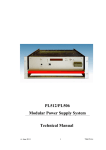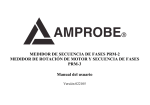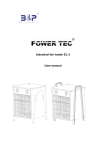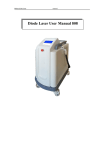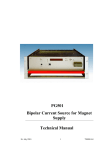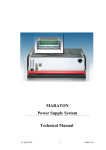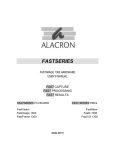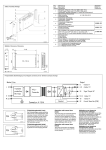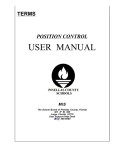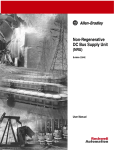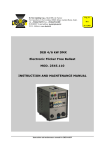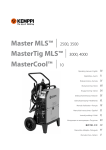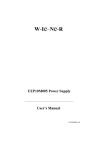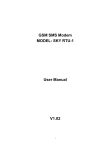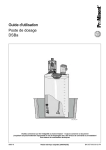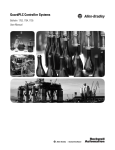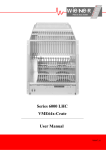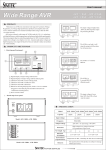Download MAraTON Power Box
Transcript
MAraTON Power Supply System Technical Manual 21. March 2012 1 *01695.A0 General Remarks The only purpose of this manual is a description of the product. It must not be interpreted as a declaration of conformity for this product including the product and software. W-Ie-Ne-R revises this product and manual without notice. Differences of the description in manual and product are possible. W-Ie-Ne-R excludes completely any liability for loss of profits, loss of business, loss of use or data, interrupt of business, or for indirect, special incidental, or consequential damages of any kind, even if W-Ie-Ne-R has been advises of the possibility of such damages arising from any defect or error in this manual or product. Any use of the product which may influence health of human beings requires the express written permission of W-Ie-Ne-R. Products mentioned in this manual are mentioned for identification purposes only. Product names appearing in this manual may or may not be registered trademarks or copyrights of their respective companies. No part of this product, including the product and the software may be reproduced, transmitted, transcribed, stored in a retrieval system, or translated into any language in any form by any means with the express written permission of W-Ie-Ne-R. Control Cabinet In the context of this user manual, the control cabinet must fulfill the requirements on fireprotective enclosures according to EN 60950 / IEC 60950 / UL 60950. All devices are intended for operation in control cabinets or in closed areas. The LAN connection and all wire connections between the different system parts must be done via shielded cable with conductive connector shells, which are fixed with screws. Furthermore, an additional fire-protective enclosure is required which must not affect proper air circulation. Mains Voltage and Connection The Power supplies are equipped with a “World”- mains input (rated voltage range: 100-240 VAC, frequency: 50-60 Hz, rated current: 16 A). Before connecting to the mains please double-check correspondence. This is a permanently connected equipment. Mains input connection at the power supply primary rectifier is done with screw terminals. A combined circuit breaker / main switch (16A at maximum operating temperature) is included. Before working at the terminals, the power mains to which the device shall be connected must be absolutely reliable switched off or disconnected. 21. March 2012 i *01695.A0 The DC output terminals are connected to hazardous voltage. After disconnecting the mains the capacitors connected to the DC-outputs must be discharged by a well isolated resistor 22 Ohm, 10 Watt. Terminal Label + PE L N Description Positive DC Output Negative DC Output Protective Earth Phase Return, Neutral Color of the Wire green/yellow black or brown blue Connection to Earth Safety After connecting the Power box to the mains, the mains input module is powered permanently. Filter and storage capacitors of the power factor correction module are charged with about 400VDC. Any DC-On-Signal as well as a power switch at control board (if any installed) operates as a low voltage DC on/off switch only and not as a mains breaker. Therefore it becomes dangerous if the box cover is open. In this case a lot of components on high voltage potential get touchable! Before starting any kind of work inside the power box remove the unit from mains and wait a couple of minutes with your activities! Discharge the primary DC Filter-capacitors by use of a well isolated 22 ohm 10W resistor. We recommend in case of any malfunction to send the power box to Wiener or to one of our representative for service 21. March 2012 ii *01695.A0 Declaration of Conformity Low Voltage Directive 73/23/EEC and EMC Directive Art. 10.1 of 89/336/EEC W-Ie-Ne-R Plein & Baus GmbH declare under our own responsibility that the product MAraTON Power Supply System Items: 0M01; 0M02; 0M05; 0PFC is in accordance with the following standards or standardized documents: 1. EN 60 950-1:2001 + Corr:2004-09 2. EN 61 000-6-3:2001 EN 55 022:1998 + Corr:2001 + A1:2000 Kl. B EN 55 022:1998 + Corr:2001 + A1:2000 Kl. B EN 61 000-3-2:2001 EN 61 000-3-3:1995 +Corr:1997 +A1:2001 EN 61 000-6-2:2001 EN 61 000-4-6:1996 + A1:2001 EN 61 000-4-3:1996 + A1:1998 + A2:2001 3. EN 61 000-4-4:1995 + A1:2001 EN 61 000-4-5:1995 + A1:2001 EN 61 000-4-11:1994 + A1:2000 EN 61 000-4-2:1995 + A1:1998 + A2:2001 Niederspannungsrichtlinie [low voltage directive] Störaussendung EMA [RF emission] Störspannung [conducted noise] Störfeldstärke [radiated noise] Oberschwingungen [harmonics] Spannungsschwankungen [flicker] Störfestigkeit EMB [immunity] HF-Einströmung [injected HF currents] HF-Felder [radiated HF fields] incl. ”900MHz” Burst Surge Spannungs-Variationen [voltage variations] ESD Conditions: This unit is not a final product and is foreseen for use inside a closed cabinet. The supplying of loads over long distances (>3m) needs possibly additional RF rejection hardware to get in conformity of the definition. Name and signature of authorized person Place and Date Juergen Baus Techn. Director Mai. 2008 21. March 2012 iii *01695.A0 Contents Declaration of Conformity...............................................................................................iii 1 General Information...............................................................................................................1 2 Primary Rectifier....................................................................................................................3 3 MAraTON Power Box...........................................................................................................5 3.1 High Voltage DC Input.................................................................................................6 3.2 Water Cooling Connection...........................................................................................7 3.3 Main Switch...................................................................................................................7 3.4 Control Connector Input.............................................................................................7 3.5 Connection of a Personal Computer............................................................................8 3.6 Control via CAN-Bus....................................................................................................9 3.7 Control of the Power Supply without PC....................................................................9 3.8 Control of the Power Supply by the “Main Switch”................................................10 4 Power Supply Adjustments..................................................................................................10 5 The Power Bin......................................................................................................................11 5.1 Temperature Probes....................................................................................................12 5.2 Sense Connection.........................................................................................................12 5.3 Status LED...................................................................................................................13 5.4 ON Jumper...................................................................................................................13 5.5 RS232............................................................................................................................14 5.6 CAN..............................................................................................................................14 6 Output Register (Optional)...................................................................................................15 7 Power Box Data Sheet..........................................................................................................17 8 Primary Rectifier Data Sheet................................................................................................20 9 Appendix A: Ordering Information......................................................................................21 9.1 Power Box....................................................................................................................21 9.2 Primary Rectifier.........................................................................................................22 10 Appendix A: Recommended Cable Specification..............................................................23 10.1 400V DC Cabling (Primary Rectifier ↔ MAraTON)............................................23 21. March 2012 iv *01695.A0 Figures Figure 1.1: MARATON System Overview..................................................................2 Figure 2.1: Primary Rectifier......................................................................................3 Figure 2.2: 4U Primary Rectifier Power Bin fox six Primary Rectifier Modules...........4 Figure 3.1: MAraTON Power Box..............................................................................5 Figure 3.2: Power Box Front......................................................................................6 Figure 3.3: Power Box Rear Side (Power Output Connections)...............................6 Figure 3.4: Programming of the Control Connector Behavior....................................8 Figure 3.5: Connection of a Personal Computer........................................................8 Figure 5.1: Power Bin Pin Assignment....................................................................11 Figure 5.2: Sense Connection Connectors..............................................................12 Figure 6.1: Output Register Schematic (one of 32)..................................................15 Figure 6.2: Output Register Connectors..................................................................15 Figure 10.1: HV DC Wiring......................................................................................23 Tables Table 1: High Voltage DC Input Connector Pin Assignment......................................6 Table 2: Control Connector Pin Assignment..............................................................7 Table 3: CAN Transmission Speed Index..................................................................9 Table 4: Power Supply Adjustment with the Rotary Switches..................................10 Table 5: Sense Connection Jumper Settings...........................................................13 Table 6: Status LED Jumper Settings......................................................................13 Table 7: ON Jumper Settings..................................................................................13 Table 8: Bin RS232 Connector Pin Assignment......................................................14 Table 9: Bin CAN Connector Pin Assignment..........................................................14 Table 10: Inhibit Connector Pin Assignment............................................................16 21. March 2012 v *01695.A0 1 General Information Features ● up to 8 independent, quasi-floating outputs, >3 kW DC output power (385VDC input), 3.6 kW water cooled A MAraTON (Magnetism Tolerant New power supply system) is a distributed power supply designed to provide up to 8 low voltage / high current channels at magnetic environment. Fully controlled, adjustable trip levels It offers up to 8 channels in a 3U high box. ● Adjustable voltages, current limits and Dynamic behavior adjustable by internal jumper (long or short sensed distances to OVP-trip levels loads). ● Extremely low noise and ripple ● ● CE conform EN 50 081/82 part 2 or 1, safety in accordance with EN 60 950 ● 385V DC input for low cross section cabling ● CAN-Bus ● Water cooled (recommended) or by forced air 21. March 2012 1 *01695.A0 The power supply system is consisting of two main components ● Primary Rectifier ● Power Box MAraTON System Overview Mains Input CAN Bus Primary Rectifier Input: 230V AC ± 10% Output: 385V DC, regulated „Safe“ Environment „Hostile“ Environment MAraTON Power Box Up to 8 Quasi-Floating DC/DC Converter Channels Figure 1.1: MARATON System Overview The Primary Rectifier is operating at locations with standard industrial conditions (Safe Environment). The Power Box is located near to the electronics which shall be supplied, and is capable to operate in a “Hostile Environment” (strong magnetic field). The distance between the DC/DC-Converter and the other components may be up to 120 m. 21. March 2012 2 *01695.A0 2 Primary Rectifier This module converts the standard mains voltage (100 V ... 230 V AC, 16 A) to a regulated DC voltage (nominal 385 V). There is no galvanic isolation. Up to 6 Primary Rectifiers can be plugged into one Primary Rectifier Bin. Primary Rectifier Bin Input: 230/400 V AC, 3 Phase, max. 32 A, max. 22 kW AC Input / DC Output Terminals Primary Rectifier EMI Input Filter Rectifier + PFC Boost Converter with Power Factor Corection EMI Output Filter Output: 385V DC 6 fold 9 A, 21 kW Figure 2.1: Primary Rectifier The screw terminal connections to the mains are separate for each Primary Rectifier. So it is possible to connect all 6 inputs in parallel to a 230V/96A mains connection. Another solution is to connect each two modules in parallel, and connect the three groups in a star connection to a 400V/230V mains (The central point conductor must be provided!). The screw terminal connections of the high voltage DC outputs may not be connected in parallel. Each output shall be routed to one (or max. two in a low power configuration) Power Box. Before working at the terminals, the power mains to which the device is connected must be absolutely reliable switched off or disconnected. The DC output terminals are connected to hazardous voltage. After disconnecting the mains the capacitors connected to the DC-outputs must be discharged by a well isolated resistor 22 Ohm, 10 Watt. 21. March 2012 3 *01695.A0 Figure 2.2: 4U Primary Rectifier Power Bin fox six Primary Rectifier Modules The conductor cross section is max. 2.5 mm², PR-Modules are plugged to a six-fold rear plug/screw terminal combination. The terminals are foreseen for wire cross section of max. 2.5mm². For different paralleled DC outputs the version 0PFC0.000P without integrated circuit breaker is available. In that case the AC inputs of the paralleled PR-Modules have to be the same phasing. Otherwise a short circuit occurs. 21. March 2012 4 *01695.A0 3 MAraTON Power Box The MAraTON Power Box uses the 385 VDC of the Primary Rectifier and generates up to 8 independent low voltage quasi-floating output voltages. Referring to the ground reference (VME-LOGIC-GND, pin 30 of the 37 pin D-Sub connector) the maximal floating voltage for proper regulation should not exceed +/-10V. MAraTON Power Box Input: 385 V DC, 11 A CAN-Bus EMI Input Filter Rectifier for non-RAD operation with AC supply 385 V DC Auxiliary Power DC-DC Converter MDC max. 8 Channels Converter Control and Observation MUH Output: Up to 8 quasi-floating channels Figure 3.1: MAraTON Power Box Voltage, current limit and the supervision limits (minimum and maximum sense voltage, maximum current) can be programmed for each channel independently via CAN-bus. A global INHIBIT input allows to disable all outputs with just one signal. 21. March 2012 5 *01695.A0 Figure 3.2: Power Box Front Figure 3.3: Power Box Rear Side (Power Output Connections) 3.1 High Voltage DC Input The DC input connections are made with the Amphenol circular connector series ECTA 133 (standard polarization: 0° rotation between insert and shell). We recommend the mating plug 1331-M-303-FS with the backshell 1330-3-PES1. DC Input Pin Signal Comment 1 2 PE DC Power Input. There is a bridge rectifier inside, so exchange of the polarity does not harm. Safety Ground + 385 V + 385 V Return Protective Earth Table 1: High Voltage DC Input Connector Pin Assignment 21. March 2012 6 *01695.A0 3.2 Water Cooling Connection The water connections are made with quick couplings series LC 6.4 mm from Colder Products Company (CPC). We recommend an elbow mating plug with shutoff, e.g. LCD230-04. Consider that water inlet and water outlet are not exchangeable. The safety valve may not be readjusted by the customer. 3.3 Main Switch The green illuminated switch works as a global inhibit input. 3.4 ● 0 Power outputs disabled ● I Switch is lighting, power outputs may be enabled by the remote control. Control Connector Input The power inhibit input (POWER) is provided to force all outputs to be switched off. The default configuration is: ● connected to GND Power outputs disabled ● floating Power outputs may be enabled by the remote control DSUB15 female Pin Signal Comment 8 15 7 14 6 13 5 12 4 11 3 10 2 9 1 reserved reserved reserved reserved reserved reserved reserved reserved Ground of the aux. supply, connected to DGND reserved Inhibit input reserved reserved reserved reserved NC NC NC +5V INTERLOCK NC GLOBAL_TRIPOFF_DISABLE NC INTERLOCK_RETURN GND CAN-H INHIBIT CAN-L NC CAN-GND NC Table 2: Control Connector Pin Assignment This default configuration can be changed with the RS232 configuration software (see manual 00461.A0) 21. March 2012 7 *01695.A0 Figure 3.4: Programming of the Control Connector Behavior The signals shall be connected by an isolated contact (e.g. relays), and must not be connected to other potentials. 3.5 Connection of a Personal Computer Equipment: A PC running Windows, the control program and a simple adapter. This RS232 connection is intended for setup and repair operation and should not be used for permanent monitoring during normal operation. 9 Pin DSUB female 9 Pin DSUB male (PL 500 F8) (PC) 3 2 8 3 7 1 kΩ Ω 5 6 1 kΩ Ω 100nF Figure 3.5: Connection of a Personal Computer 21. March 2012 8 *01695.A0 Note: If you use Pin 3 and 8 for a serial connection to a computer, you can’t use this pins any more for the „Remote On“ and „Status Out“ functions and you can neither connect the power supply to an alphanumeric control panel (see below 4) nor operate with remote on / off (see below 3). 3.6 Control via CAN-Bus The CAN Bus Signals are provided on the 9 Pin DSUB of the power supply. This pinning is NOT identical to the 9-pin DSUB of the power bin! CAN_H: Pin 5 CAN_L: Pin 9 CAN_GND: Pin 4 The software protocol is described in a separate document (Part No *00183) Index 0 1 2 3 4 5 6 7 8 9 Max. Distance 10 m 40 m 130 m 270 m 530 m 620 m 1.300m 3.300 m 6.700 m 10.000 m Bit Rate 1.6 Mbit/s 1.0 Mbit/s 500 kbit/s 250 kbit/s 125 kbit/s 100 kbit/s 50 kbit/s 20 kbit/s 10 kbit/s 5 kbit/s Type high- speed (needs termination) low-speed Table 3: CAN Transmission Speed Index 3.7 Control of the Power Supply without PC There is a remote on/off input and a status output function: Remote On: 9 Pin DSUB: Close a “make” contact or switch between Pin 8 (Serial Data In) and Pin 2 or 7. Status Output: 9 Pin DSUB: Connect a LED between Pin 3 (Serial Data Out,+) and Pin 1 or 6. 21. March 2012 9 *01695.A0 3.8 Control of the Power Supply by the “Main Switch” Use “mains switch” at the rear side to start the power supply. Also this optional rocker switch acts as a DC on / off switch and doesn’t disconnect mains from the unit! 4 Power Supply Adjustments All output voltages can be adjusted manually via the two rotary switches situated on the power supply top. 1. the 1. rotary switch selects the function which has to be adjust 2. the 2. rotary switch will change the settings when turned (right/left = +/-) Channel selection (0:Uo...7:U7) (A-D: CANbus) Adjustment + Mode Function Selection 0-7 Adjust Voltage of U0-U7 A CAN Address (low, Bit 0-3) B CAN Address (high, Bit 4-6) C CAN General Call Address (low, Bit 0-3) D CAN General Call Address (high, Bit 4-6) E CAN Transmission Speed Index Table 4: Power Supply Adjustment with the Rotary Switches To change the CAN-Bus parameters, the following sequence is recommended (Example: address 58 = 0x3A, general call address 127 = 0x7F, transmission speed index 1): 1. Set the MODE to “A” 2. Set the ADJUST to the low address value (“A”) 3. Set the MODE to “B” 4. Set the ADJUST to the high address value (“3”) 5. Set the MODE to “C” 21. March 2012 10 *01695.A0 6. Set the ADJUST to the low G. Call address value (“F”) 7. Set the MODE to “D” 8. Set the ADJUST to the high G. Call address value (“7”) 9. Set the MODE to “E” 10. Set the ADJUST to the speed index (“1”) 11. Set the MODE to “F” (park position) 5 The Power Bin For easy exchange of the MAraTON Power Box the special bin is provided: The low voltage/high current cabling is connected to M8 (pin 1..9 and 12) and M6 (pin 10, 11 and 13..18) threaded bolts (MULTICONTACT). 18 15 12 9 6 3 - + - + - + Sense 17 14 11 8 5 2 Connection - - - - - - Board 16 13 10 7 4 1 + + + + + + Figure 5.1: Power Bin Pin Assignment 21. March 2012 11 *01695.A0 Figure 5.2: Sense Connection Connectors 5.1 Temperature Probes Up to 8 temperature probes (Silicon sensor KTY81-110) may be connected to the T0/T0R ... T7/T7R terminals). 5.2 Sense Connection The sense lines (terminal U0+/U0- ... U7+/U7-) must be connected to the power output lines at the load for propper regulation. The sense difference amplifiers of all power modules are connected to a common auxiliary power supply. This amplifiers have a specific measurement range (input common mode), and it must be satisfied that all sense voltages remain inside this common mode operating range. To achive this either the positive or negative sense line of each channel must be connected to the digital ground (DG). This connection can be made by setting a jumper at the 3-pin jumper posts DG0...DG7: 21. March 2012 12 *01695.A0 -DG+ Negative sense line connected to digital ground. Positive sense line connected to digital ground. Table 5: Sense Connection Jumper Settings 5.3 Status LED The green STATUS LED displays the status of the power supply. ● OFF Power is off ● ON Power is on ● BLINKING Any Failure The status line of the power supply is shared with the serial (RS232) communication. The functionallity is selected with the C/LED jumper: C/LED RS232 communication active, LED unused LED active, no RS232 communication possible Table 6: Status LED Jumper Settings 5.4 ON Jumper It is possible to switch the power supply on without remote control. The power on line of the power supply is shared with the serial (RS232) communication. The functionallity is selected with the ON jumper: ON RS232 communication active POWER ON, no RS232 communication Table 7: ON Jumper Settings 21. March 2012 13 *01695.A0 5.5 RS232 DSUB9 female Pin Signal Comment 1 6 2 7 3 8 4 9 5 reserved reserved TXD output of the power supply reserved RXD input of the power supply reserved reserved reserved GND NC NC TXD NC RXD NC NC NC GND Table 8: Bin RS232 Connector Pin Assignment 5.6 CAN DSUB9 male Pin Signal Comment 1 6 2 7 3 8 4 9 5 reserved reserved CAN-bus LOW signal CAN-bus HIGH signal CAN-bus GND reserved reserved reserved reserved NC NC CAN-L CAN-H CAN-GND NC NC NC NC Table 9: Bin CAN Connector Pin Assignment 21. March 2012 14 *01695.A0 6 Output Register (Optional) This is a special option designed for the CERN CMS experiment. In addition of the elements of the standard sense connection board this circuit provides 32 quasi-floating digital outputs, which can be set via CAN-bus. Figure 6.1: Output Register Schematic (one of 32) The +15VAUX_RETURN of the auxiliary power supply is connected to the digital ground (DG) inside of the power supply. For the functionallity of this circuit it is essential to connect the sense lines with the digital ground, too (see 5.2 Sense Connection on page 12). 21. March 2012 15 *01695.A0 Figure 6.2: Output Register Connectors DSUB37 male Pin 1 20 2 21 3 22 4 23 5 24 6 25 7 26 8 27 9 28 10 29 11 30 12 31 13 32 14 33 15 34 16 35 17 36 18 37 19 X1 INHIBIT 16 INHIBIT RETURN 16 INHIBIT 17 INHIBIT RETURN 17 INHIBIT 18 INHIBIT RETURN 18 INHIBIT 19 INHIBIT RETURN 19 INHIBIT 20 INHIBIT RETURN 20 INHIBIT 21 INHIBIT RETURN 21 INHIBIT 22 INHIBIT RETURN 22 INHIBIT 23 INHIBIT RETURN 23 INHIBIT 24 INHIBIT RETURN 24 INHIBIT 25 INHIBIT RETURN 25 INHIBIT 26 INHIBIT RETURN 26 INHIBIT 27 INHIBIT RETURN 27 INHIBIT 28 INHIBIT RETURN 28 INHIBIT 29 INHIBIT RETURN 29 INHIBIT 30 INHIBIT RETURN 30 INHIBIT 31 INHIBIT RETURN 31 NC NC NC NC NC X0 INHIBIT 0 INHIBIT RETURN 0 INHIBIT 1 INHIBIT RETURN 1 INHIBIT 2 INHIBIT RETURN 2 INHIBIT 3 INHIBIT RETURN 3 INHIBIT 4 INHIBIT RETURN 4 INHIBIT 5 INHIBIT RETURN 5 INHIBIT 6 INHIBIT RETURN 6 INHIBIT 7 INHIBIT RETURN 7 INHIBIT 8 INHIBIT RETURN 8 INHIBIT 9 INHIBIT RETURN 9 INHIBIT 10 INHIBIT RETURN 10 INHIBIT 11 INHIBIT RETURN 11 INHIBIT 12 INHIBIT RETURN 12 INHIBIT 13 INHIBIT RETURN 13 INHIBIT 14 INHIBIT RETURN 14 INHIBIT 15 INHIBIT RETURN 15 NC NC NC NC NC Comment reserved reserved reserved reserved reserved Table 10: Inhibit Connector Pin Assignment 21. March 2012 16 *01695.A0 7 Power Box Data Sheet 3U box with max. 6 power modules. Input: Rated Input Voltage: Rated Input Current: Output Insulation (SELF) 385 V DC +/- 10 V 11 A CE EN 60950 , ISO 380, VDE 0805, UL 1950, C22.2.950 Regulation fast remote sense circuit (short sensed distance, sense connected to output at the MARA power bin): Static: Dynamic (0.5 m wire): Recovery Time: Conditions MDC/M 2-8 V / 30–60 V < 15 mV (+/-100% load, +/- full mains range) MDC/M other voltages < 0.05 % (+/-100% load, +/- full DC input range) MDC/M 2-8 V < 100 mV (50 % - 75 % load change) other < 0.7 % (50 % - 75 % load change) MDC/M 2-8V 1%: 0.2 ms (50 % - 75 % load change) 0.1%: 0.5 ms MDC/M 5-16V, 7-24V 1%: 0.0 ms (50 % - 75 % load change) 0.1%: 1.0 ms MDC/M 30-60V 1%: 0.5 ms (50 % - 75 % load change) 0.1%: 1.0 ms Current slope <1000A/ms, 20mF per 100A parallel to load Regulation slow remote sense circuit (long sensed distance): Static: Dynamic: MDC/M 2-8V/ 30-60V < 15 mV (+/-100% load, +/- full mains range) Other < 0.05 % (+/-100% load, +/- full mains range) Dynamic deviation depends on current slope resp. filter capacitors at load side only 30m cable to load, 0,3mF capacitance at load side, 1V drop at nominal load, 10% - 90 % load change with 3ms slope (50A output= 13,33A/ms) leads to less than 10% temporary output voltage deviation Recovery Time (40m MDC 2-7V, 2-8V wire, 5V at load side, Udrop < 2 V: Other 21. March 2012 10%: <15 ms (50 % - 75 % load change) 1%: <25 ms 10%: <15 ms (50 % - 75 % load change) 1%: < 33 ms 17 *01695.A0 DC Output Characteristics: Sense compensation range: Limited to < 10V or nominal voltage (whichever is lower). Regulation mode: The voltage at the sense connection point is regulated. Floating range: min. +/-10V Noise and ripple: Voltage < 8 V Voltage > 8 V < 10 mVPP < 15 mVPP (0.5 m wire, 0–20 MHz) < 3 mVPP (10 m wire, 0-300 MHz) < 1.5 mVRMS Conditions at the load: Parallel (X) 330µF and 1µF ceramic, 100nF HF- conducting to case (Y) each line Emission: CE EN 50081-1 (EN 55 022-B) Immunity: CE EN 50082-1 or 2 Operating temperature: 10 °C – 40 °C Storage Temperature: - 30 °C - + 85 °C (cooling water must be completely removed, else +3 °C - +85 °C) Temp.- Coefficient: < 0.2% / 10K Stability (constant conditions) <5mV or 0.1% within 24 h, <25mV or 0.3% within 6 months Current limiting: Programmable via CAN bus. Status control / DC Off (trip off): Processed in external Remote Controller. Tripping global, group- or channel wise programmable (after overload, overheat , overvoltage, undervoltage) Efficiency (pro Module): 65% 2V/ -81% >5V/ -85% >7V -87% >12V/ -90% >48V at nominal input voltage M T B F, cooled by: Conditions: 3kW DC output with 80% efficiency (600W internal power dissipation: WORST CASE) Water, 30°C inflow: Forced Air, 30°C entrance: ca. 120,000 h , put through > 50l/h for <10°C DT of cooling water. Minimum differential pressure >0.5 bar, abs. max. pressure <15bar ca. 90,000 h , put through > 153m3/h for <15°C DT of cooling air, ambient air pressure 1 bar. Adequate airflow is roughly 1,4m/s. Values for air cooled units are valid for new ones. Abrasive dust, corrosion, etc. can limiting the heat transfer to the cooling air during lifetime. Higher operating temperature is the consequence. Increasing of internal temperater at the most critical points of 10°C 21. March 2012 18 *01695.A0 will reduce the MTBF by 50% Lower operating temperatures will increase the MTBF accordingly, independent of cooling medium. Construction features, Accessories: Accessories: 21. March 2012 3 U box with extraction lever: max. 6 modules, up to 3 kW / 3,6kW output power Connections / plugs: 24 female pins 80A, parallel used for higher currents, 3 x 9pin Sub D for sensing (each for 4 channels) Dimensions (w, h, d) 434 mm x 132 mm x 325 mm Weight: 31,5 kg 19" Power Bin for plug in MAraTON power supplies. 18 power contacts with M6/M8 threated bolts and sense terminals at rear side. 19 *01695.A0 8 Primary Rectifier Data Sheet Mains Input AC Input: power fact. >0,98 CE 100- 240VAC / 16A +/-10% (20A peak), 47-63Hz, Inrush current: (cold unit) limited by soft start-circuit to 110% of nominal current Input protection: Circuit breaker with 20A thermal overload protection (16 A at maximum operating temperature) included. Power Output: converter 385 V DC +/- 5V, matched for MARATON DC/DC continuously 9A, 3500W nominal (4,4kW peak) @ 230VAC input Regulation: Load (10-90%) Mains (10-90%) 1% deviation 1% deviation Output ripple: frequency) Load (10-90%) 1-10Vss 94-126Hz (double mains RF rejection: EN 55 022 Class B, Input and Output Output protection overload: current limiting for booster circuits, 90°C cut off temperature Dimensions: 4U x 14 PU width acc. to IEC 60297, 450 mm deep Weight: 4,7 kg Module connectors: 2mm pin / socket diameter. max. ratings: 25A up to 50°C, 500V. 2,2kV test voltage 50Hz PE / Ground pins outfitted as leading pin EMC Compatibility /RFI Rejection Separate Input and Output EMC Filter EMA EN 61 000-6-3:2001 [RF emission] EN 55 022:1998 + Corr:2001 + A1:2000 Class B conducted noise EN 55 022:1998+ Corr:2001 + A1:2000 Class B radiated noise EN 61 000-3-2:2001 harmonics EN 61 000-3-3:1995 +Corr:1997 +A1:2001 flicker EMB EN 61 000-6-2:2001 [immunity] EN 61 000-4-6:1996 + A1:2001 EN 61 000-4-3:1996 + A1:1998 + A2:2001 EN 61 000-4-4:1995 + A1:2001 EN 61 000-4-5:1995 + A1:2001 EN 61 000-4-11:1994 + A1:2000 EN 61 000-4-2:1995 + A1:1998 + A2:2001 injected HF currents radiated HF fields incl. 900MHz Burst Surge voltage variations ESD Operation temperature: 0....50°C without derating, storage: -30°C … + 85°C Efficiency: better than 95 % MTBF electronics: 40°C ambient: ca. 100 000 h integrated fan: 40°C ambient: ca. 65 000 h, 25° ambient >85000h 21. March 2012 20 *01695.A0 9 9.1 Appendix A: Ordering Information Power Box The power boxes can be classified into four categories, which define the most significant part of the ordering number: With magnetic screening (120 mT external field): Standard Output Register Option Air Cooled 0M01.xxxx 0M01.xxxxR Water Cooled 0M02.xxxx 0M02.xxxxR Standard Output Register Option 0M05.xxxx 0M05.xxxxR Without magnetic screening: Water Cooled The right side of the ordering number is not descriptive, it is randomly assigned to the requested module & options configuration. Up to six power modules may be used inside of one power box. The following modules are possible: Module Type Channels per Optimal Voltage Peak Output Continuous Module Range Current Output Power MDC 2 2V ... 7V/8V 2*55A 2*300W MDC 2 5/7V ... 15/16V 2*22A 2*300W MDC 2 9V 2*30A 2*270W MDC 2 7V ... 24 V 2*11.5A 2*250W MDC 2 30V ... 60V 2*6.6A 2*300W The MDC 7V and MDC 9V are available with the special “maximum voltage ensured” option. With this option the modules are designed in a way that even in the worst case (All electronic regulation and protection fails and the PWM generates it's maximum duty cycle) the output voltage does not rise. Please contact WIENER for more details. All power modules can be ordered with different sense regulation characteristics: 21. March 2012 21 *01695.A0 ● Fast Fastest regulation, but may be instable if connected to cables longer than 1 m. ● Moderate This is the standard configuration for cable length up to 30 m ● Slow This is used for much longer cables Available Power Bins: Ordering Number 9.2 Power Bin (MARA) 3U 0B15.1200 Power Bin (MARA) 6U, for two power boxes 0B14.2400 Primary Rectifier Ordering Number Primary Rectifier Module (PFC) 0PFC.0001 Power Bin for 6 PFC Modules 0B07.0001 21. March 2012 22 *01695.A0 10 Appendix A: Recommended Cable Specification 10.1 400V DC Cabling (Primary Rectifier ↔ MAraTON) The cable selections are based on max. 10V voltage drop at the cable, at max. current of 10A (total cable resistance ≤ 1 Ω) maximum number of wires / LAPP part no.1 LAPP length cross section not halogen-free halogen-free 40 m 2 x 1.5 mm² 1135 902 2X1,5 0035 067 2X1,5 65 m 2 x 2.5 mm² 1135 402 2X2,5 80 m 4 x 1.5 mm² (2 1135 904 4X2,5 0035 wires in parallel) no.2 part 070 4G1,5 (standard cable only with gn/ye color) 105 m 2 x 4 mm² 1135 502 130 m 4 x 2.5 mm² (2 1135 wires in parallel) 2X4,0 404 (standard 4G2,5 0035 cable only (standard available with gn/ye color) 160 m 2 x 6 mm² 1135 602 up to 1.5m, unscreened 090 4G2,5 cable only available with gn/ye color) 2X6,0 up to 1.5m, unscreened up to 160 m, screened Patch Pannel Patch Pannel Primary Rectifier MARATON Safety Earth Figure 10.1: HV DC Wiring 1 ÖLFLEX® CLASSIC 110 CY, U0/U: 300/500 V, Datasheet: http://www.lappkabel.de/webkatalog/katalog.cfm?cmd=show_produkt_details&produkt_id=10016 2 ÖLFLEX® CLASSIC 110 CH, U0/U: 300/500 V, Datasheet: http://www.lappkabel.de/webkatalog/katalog.cfm?cmd=show_produkt_details&produkt_id=10035 21. March 2012 23 *01695.A0
































